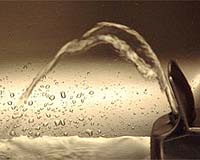| . |  |
. |
Mumbai, India (SPX) Jul 30, 2010 Nanotechnology refers to a broad range of tools, techniques and applications that simply involve particles on the approximate size scale of a few to hundreds of nanometers in diameter. Particles of this size have some unique physicochemical and surface properties that lend themselves to novel uses. Indeed, advocates of nanotechnology suggest that this area of research could contribute to solutions for some of the major problems we face on the global scale such as ensuring a supply of safe drinking water for a growing population, as well as addressing issues in medicine, energy, and agriculture. Writing in the International Journal of Nuclear Desalination, researchers at the D.J. Sanghvi College of Engineering, in Mumbai, India, explain that there are several nanotechnology approaches to water purification currently being investigated and some already in use. "Water treatment devices that incorporate nanoscale materials are already available, and human development needs for clean water are pressing," Alpana Mahapatra and colleagues Farida Valli and Karishma Tijoriwala, explain. Water purification using nanotechnology exploits nanoscopic materials such as carbon nanotubes and alumina fibers for nanofiltration, it also utilizes the existence of nanoscopic pores in zeolite filtration membranes, as well as nanocatalysts and magnetic nanoparticles. Nanosensors, such as those based on titanium oxide nanowires or palladium nanoparticles are used for analytical detection of contaminants in water samples. The impurities that nanotechnology can tackle depend on the stage of purification of water to which the technique is applied, the team adds. It can be used for removal of sediments, chemical effluents, charged particles, bacteria and other pathogens. They explain that toxic trace elements such as arsenic, and viscous liquid impurities such as oil can also be removed using nanotechnology. "The main advantages of using nanofilters, as opposed to conventional systems, are that less pressure is required to pass water across the filter, they are more efficient, and they have incredibly large surface areas and can be more easily cleaned by back-flushing compared with conventional methods," the team says. For instance, carbon nanotube membranes can remove almost all kinds of water contaminants including turbidity, oil, bacteria, viruses and organic contaminants. Although their pores are significantly smaller carbon nanotubes have shown to have an equal or a faster flow rate as compared to larger pores, possibly because of the smooth interior of the nanotubes. Nanofibrous alumina filters and other nanofiber materials also remove negatively charged contaminants such as viruses, bacteria, and organic and inorganic colloids at a faster rate than conventional filters. "While the current generation of nanofilters may be relatively simple, it is believed that future generations of nanotechnology-based water treatment devices will capitalize on the properties of new nanoscale materials," the team says. The researchers point out that several fundamental aspects of nanotechnology have raised concerns among the public and activist groups. They concede that the risks associated with nanomaterials may not be the same as the risks associated with the bulk versions of the same materials because the much greater surface area to volume ratio of nanoparticles can make them more reactive than bulk materials and lead to so far unrecognized and untested interactions with biological surfaces. Water purification based on nanotechnology has not yet led to any human health or environmental problems but the team echoes the sentiment of others that further research into the biological interactions of nanoparticles should be carried out.
Share This Article With Planet Earth
Related Links D.J. Sanghvi College of Engineering Water News - Science, Technology and Politics
 UN declares access to clean water a human right
UN declares access to clean water a human rightUnited Nations (AFP) July 28, 2010 The UN General Assembly on Wednesday recognized access to clean water and sanitation as a human right, a move hailed by water advocates as a momentous step toward a future treaty. After more than 15 years of contentious debate on the issue, 122 countries voted in favor of a compromise Bolivian resolution enshrining the right, while the United States, Britain, Canada, Australia and 37 other ... read more |
|
| The content herein, unless otherwise known to be public domain, are Copyright 1995-2010 - SpaceDaily. AFP and UPI Wire Stories are copyright Agence France-Presse and United Press International. ESA Portal Reports are copyright European Space Agency. All NASA sourced material is public domain. Additional copyrights may apply in whole or part to other bona fide parties. Advertising does not imply endorsement,agreement or approval of any opinions, statements or information provided by SpaceDaily on any Web page published or hosted by SpaceDaily. Privacy Statement |